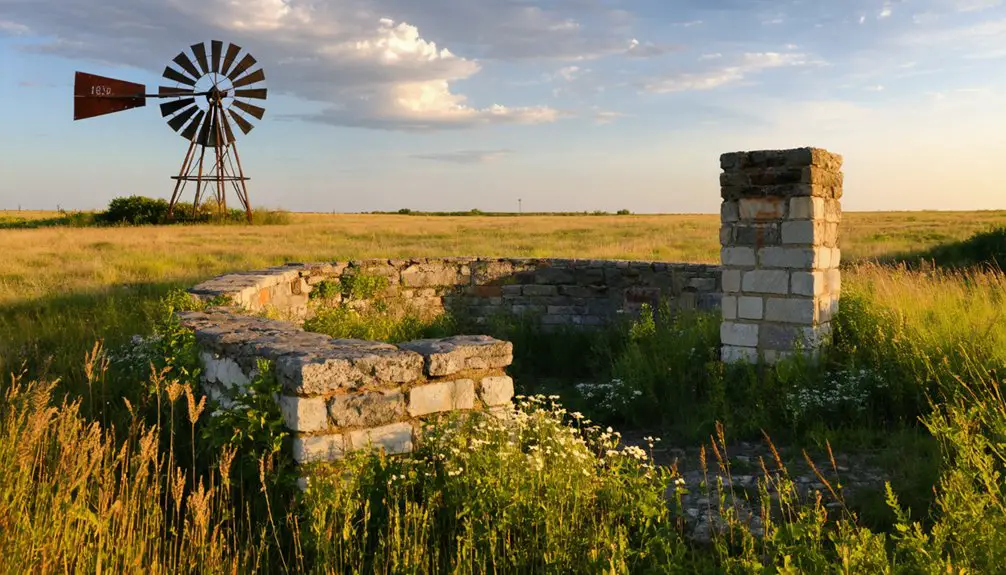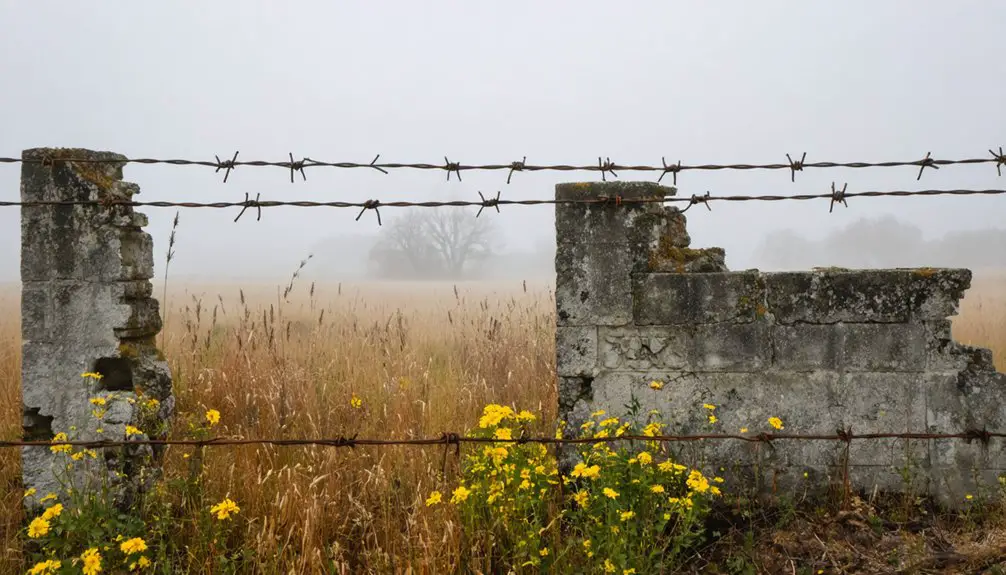You’ll find Stockdale’s remains at the confluence of Mill Creek and Big Blue River in Riley County, Kansas. Founded in 1873 by Michner Condray, this once-thriving settlement grew around its strategic location and 1881 railroad connection. The town flourished until Tuttle Creek Lake’s construction in 1952 submerged most structures. Today, you can explore limestone ruins, weathered bridge foundations, and Bryant Cemetery during low water periods, where each artifact reveals chapters of frontier determination.
Key Takeaways
- Stockdale was founded in 1873 at the confluence of Mill Creek and Big Blue River in Riley County, Kansas.
- The town flourished after trains arrived in 1881, becoming a significant hub for commerce and agriculture.
- Tuttle Creek Lake’s construction in 1952 submerged many of the town’s original structures.
- Remnants include the Bryant Cemetery, weathered bridge foundations, and old railroad beds visible along the riverbanks.
- Economic decline occurred due to farming technology advancements, youth migration to cities, and weakening railroad connections.
Location and Geographic Features
The ghost town of Stockdale lies at the confluence of Mill Creek and the Big Blue River in Grant Township, Riley County, Kansas. You’ll find this historical site at coordinates 39.3083298°N, -96.6502839°W, where it sits at an elevation of 1,076 feet above sea level.
The Stockdale geography features rich prairie soils that once supported thriving agricultural operations. Similar to place name patterns seen across English-speaking regions, Stockdale derived its title from early settlers. Today, visitors must undergo identity verification before accessing certain protected historical areas.
Rich Kansas prairie land nourished generations of farmers at Stockdale, where fertile soil once yielded bountiful harvests.
The area’s river ecosystems remain vibrant, with deciduous forests lining the waterways and providing habitat for deer, turkey, and diverse birdlife. The Big Blue River serves as the primary watercourse through the region, while Mill Creek, its tributary, adds to the area’s water resources.
You can explore this ghost town’s natural setting through the Olsburg SW USGS map, which details the mainly flat plains and rolling hills characteristic of the region.
Early Settlement and Pioneer Life
Founded by Michner Condray in 1873, Stockdale emerged as a strategic settlement at a time when Kansas towns enthusiastically anticipated railroad expansion.
You’ll find that when the trains finally arrived in 1881, they transformed this frontier outpost into a bustling hub of commerce and agriculture.
Life wasn’t easy for Stockdale’s pioneers. They’d face brutal weather, isolation, and limited access to essential services. Similar to the Swedish settlement of Sveadal, the town faced significant challenges in establishing itself. Like Columbia’s early settlers, establishing land claims was difficult due to a lack of official surveys.
Yet they’d persevere through these pioneer hardships, developing agricultural innovations that suited the local soil and climate.
Mr. Sweet’s store became a lifeline, providing vital supplies to farmers and residents alike. The establishment of a post office further connected the community to the outside world.
Despite the challenges, you’ll see how these early settlers built a resilient community through determination and adaptability.
Rise and Development
In 1873, you’d find Stockdale strategically positioned where Chapman Creek met the Republican River, making it an appealing location for early settlers seeking water access and fertile valley lands.
The town’s founders envisioned Stockdale becoming a crucial transportation hub, capitalizing on both waterway connections and anticipated railroad routes through the region. Similar to Bell Plane Town Company that spent $399.99 on land purchases, early investors saw potential in acquiring property near vital transportation routes.
While river transport offered initial promise, Stockdale’s development remained constrained by reliance on primitive roads and trails until railroad plans materialized. Like many of the ghost towns in Kansas, Stockdale represented one of thousands of communities that emerged during the state’s early development period.
Settlement Along River Junction
Situated at the strategic confluence of Mill Creek and Big Blue River, Stockdale emerged as a promising settlement in 1857-1858 when European pioneers L. Pierson and N. Christenson staked their claims.
You’ll find that early settler experiences centered around harnessing the rivers’ power for essential industries like sawmills and grist-mills, with August Winkler establishing the first permanent milling operation.
The fertile river valley, previously home to Native American tribes, proved ideal for agricultural practices. The waterways didn’t just support farming – they created crucial transportation routes that connected settlers to broader markets, similar to the routes that protected Oregon trails at Fort Riley.
You can trace the community’s rapid growth through the establishment of Richard Bork’s general store in 1872 and J.D. Sweet’s combination store and blacksmith shop, serving the increasing population of farmers and tradesmen who’d made Stockdale their home. The town’s proximity to Farmers Lodge No. 166 helped foster a strong sense of community among local agricultural workers.
Early Transportation Routes
While Stockdale’s riverside location shaped its early development, the settlement’s growth truly accelerated with the emergence of major transportation routes across Kansas.
You’d have seen the transformation of overland transportation in the 1820s when Becknell pioneered the Santa Fe Trail, introducing wheeled wagons across challenging terrains west of what’s now Dodge City. The wagon routes served as lifelines for settlements like Stockdale, connecting them to crucial trade networks. By 1843, trade along these routes had reached an impressive annual value of $450,000.
During the 1860s, you would’ve witnessed the Pony Express riders galloping through Kansas, following established trails from St. Joseph, Missouri. The arrival of the Hannibal and Saint Joseph Railroad in 1859 marked a significant advancement in the region’s transportation capabilities.
These early routes, combining river transport with mule-drawn wagons and horseback travel, proved essential for Stockdale’s growth before the railroads pushed westward from St. Louis in the 1850s.
Contributing Factors to Decline
As farming technology advanced throughout the 20th century, Stockdale experienced a dramatic transformation that would ultimately lead to its demise.
You’d have witnessed larger farms requiring fewer workers, triggering widespread economic decline as young residents left for urban opportunities. The town’s liveliness diminished when its railroad connections weakened, isolating it from essential commerce and travel routes.
The community disintegration accelerated as local businesses shuttered and social gathering places disappeared. Without schools, churches, and markets to sustain daily life, remaining residents found it harder to maintain their traditional support networks.
Environmental challenges and deteriorating infrastructure made it increasingly difficult to attract new residents or businesses, creating a downward spiral that sealed Stockdale’s fate as another Kansas ghost town.
Physical Remnants and Historical Sites

If you visit Stockdale’s former site along Mill Creek today, you’ll find scattered remnants marking where this once-bustling settlement stood at a key transportation junction.
The creek’s waters still flow past deteriorating foundations and overgrown pathways that hint at the town’s original layout near the former railroad crossing.
Historical markers now guide visitors through what remains of this 19th-century community, including traces of the old mill operations that once drove the local economy.
Mill Creek Settlement Traces
Located at the strategic confluence of Mill Creek and Big Blue River, the Mill Creek settlement emerged in the mid-1850s with Henry Condray and his sons establishing the area’s first permanent structures.
Pioneer families built their homes along the creek valley, taking advantage of the abundant water power for mills and industry.
You’ll find traces of this settlement’s rich history through:
- August Winkler’s grist-mill remnants, once the county’s first permanent mill
- A former schoolhouse converted to a private residence, indication of the area’s educational legacy
- The original Stockdale post office location at Mill Creek’s mouth
- J.D. Sweet’s blacksmith shop and store sites, where local farmers once gathered for supplies
Today, these physical reminders stand as silent witnesses to the determination of early settlers who shaped this frontier community.
Historic Junction Landmarks
Beyond the Mill Creek settlement traces, Stockdale’s historic junction reveals a rich tapestry of 19th-century landmarks.
You’ll find remnants of the 1885 railroad depot, named after official Laam Young, where old rail beds and infrastructure mark this once-thriving ghost town of 300 residents. The strategic confluence of Mill Creek and Big Blue River shaped the settlement’s geography, with weathered bridge foundations still visible along the riverbanks.
Bryant Cemetery stands as one of the most significant historic landmarks, preserving the stories of early settlers through its gravestones.
While Tuttle Creek Lake’s construction in 1952 submerged many original structures, you can explore hiking trails that expose limestone ruins during low water periods, offering glimpses into Stockdale’s past at this historic river junction.
Legacy in Riley County History
Stockdale’s legacy in Riley County history stands as a tribute to the rise and fall of river-based settlements during Kansas’s territorial expansion.
You’ll find its cultural significance preserved through historical documentation in county records, maps, and local heritage studies.
Consider these key aspects of Stockdale’s enduring impact:
- Its mention in the 1878 Gazetteer and 1912 Kansas Cyclopedia establishes its role in early Kansas settlement patterns.
- The town’s location at Mill Creek and Big Blue River junction exemplifies strategic waterway settlements.
- Its transformation from a thriving community to a ghost town mirrors broader economic shifts in Kansas.
- Local historians continue studying Stockdale as part of Riley County’s vanished communities, preserving its story for future generations.
Frequently Asked Questions
What Role Did Native American Tribes Play in the Stockdale Area?
You’ll find the Kanza tribe dominated the area through tribal interactions until 1854, while their cultural influences shaped early settlement patterns along waterways before federal removal policies forced their displacement.
Were There Any Famous Residents or Notable Visitors to Stockdale?
Unlike Paris’s famous Champs-Élysées, you won’t find records of any famous residents or notable visitors in Stockdale’s history. The town remained a quiet railroad stop with everyday folks.
What Types of Businesses and Industries Operated in Stockdale?
You’d find lead and zinc mining operations were the town’s backbone, alongside general stores, hotels, brothels, and churches. Later, agricultural practices like farming and ranching became prominent after mining declined.
Did Stockdale Have a School System or Religious Institutions?
You won’t find definitive records of school history or religious significance in the records. While similar towns had schools and churches, there’s no direct evidence they existed in this location.
What Was the Peak Population of Stockdale During Its Existence?
You won’t find precise historical records of Stockdale’s peak population, as this information hasn’t been preserved. Due to its limited historical significance, population figures from this Kansas settlement remain unknown.
References
- https://www.youtube.com/watch?v=x0G1GMLRrF8
- https://www.youtube.com/watch?v=PfThSLZOtqg
- https://en.wikipedia.org/wiki/List_of_ghost_towns_in_Kansas
- https://legendsofkansas.com/riley-county-extinct-towns/
- https://www.kcur.org/arts-life/2022-04-09/ghost-towns-are-all-around-kansas-city-if-you-know-where-to-look
- https://en.wikipedia.org/wiki/Brookdale
- https://www.topozone.com/kansas/riley-ks/locale/stockdale-historical/
- https://en.wikipedia.org/wiki/Riley_County
- https://afsa.org/sites/default/files/fsj-1942-05-may_0.pdf
- https://digging-history.com/2014/10/29/ghost-town-wednesday-sveadal-mcpherson-county-kansas/



